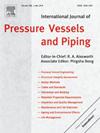Study on explosion forming of the liquid hydrogen spherical storage tank by GIMP simulation and experiment
IF 3
2区 工程技术
Q2 ENGINEERING, MECHANICAL
International Journal of Pressure Vessels and Piping
Pub Date : 2024-12-30
DOI:10.1016/j.ijpvp.2024.105426
引用次数: 0
Abstract
Spherical tanks with a volume of more than 200 m3 are usually used for the transport and storage of liquid hydrogen, liquid hydrogen spherical storage tanks are mainly manufactured using the split forming and welding technique, which has a long production cycle and high cost. To improve the production efficiency and manufacturing accuracy of spherical tanks and reduce the manufacturing cost, the theoretical model of explosion forming and the manufacturing technology of liquid hydrogen spherical storage tanks are proposed in this paper. Based on the energy criterion, the modeling law formula for the explosion forming of liquid hydrogen spherical tanks is derived. The explosion forming parameters are calculated according to the modeling law, numerical models of the generalized interpolation material point (GIMP) method and LS-DYNA finite element software are constructed according to the modeling law, which is used to simulate the explosion forming process of liquid hydrogen spherical tanks and to conduct the experiment on the explosion forming of scaling model for the liquid hydrogen storage tank. Following a quantitative comparative analysis, the numerical simulation of the explosion forming for liquid hydrogen spherical storage tanks is found to be in agreement with the experimental results. The results show that the modeling law, the numerical simulation of the GIMP method, and the scale model experiment of explosion forming can provide a theoretical basis and accurate technical parameters for the explosion forming of liquid hydrogen spherical storage tanks with various volumes.
求助全文
约1分钟内获得全文
求助全文
来源期刊
CiteScore
5.30
自引率
13.30%
发文量
208
审稿时长
17 months
期刊介绍:
Pressure vessel engineering technology is of importance in many branches of industry. This journal publishes the latest research results and related information on all its associated aspects, with particular emphasis on the structural integrity assessment, maintenance and life extension of pressurised process engineering plants.
The anticipated coverage of the International Journal of Pressure Vessels and Piping ranges from simple mass-produced pressure vessels to large custom-built vessels and tanks. Pressure vessels technology is a developing field, and contributions on the following topics will therefore be welcome:
• Pressure vessel engineering
• Structural integrity assessment
• Design methods
• Codes and standards
• Fabrication and welding
• Materials properties requirements
• Inspection and quality management
• Maintenance and life extension
• Ageing and environmental effects
• Life management
Of particular importance are papers covering aspects of significant practical application which could lead to major improvements in economy, reliability and useful life. While most accepted papers represent the results of original applied research, critical reviews of topical interest by world-leading experts will also appear from time to time.
International Journal of Pressure Vessels and Piping is indispensable reading for engineering professionals involved in the energy, petrochemicals, process plant, transport, aerospace and related industries; for manufacturers of pressure vessels and ancillary equipment; and for academics pursuing research in these areas.

 求助内容:
求助内容: 应助结果提醒方式:
应助结果提醒方式:


